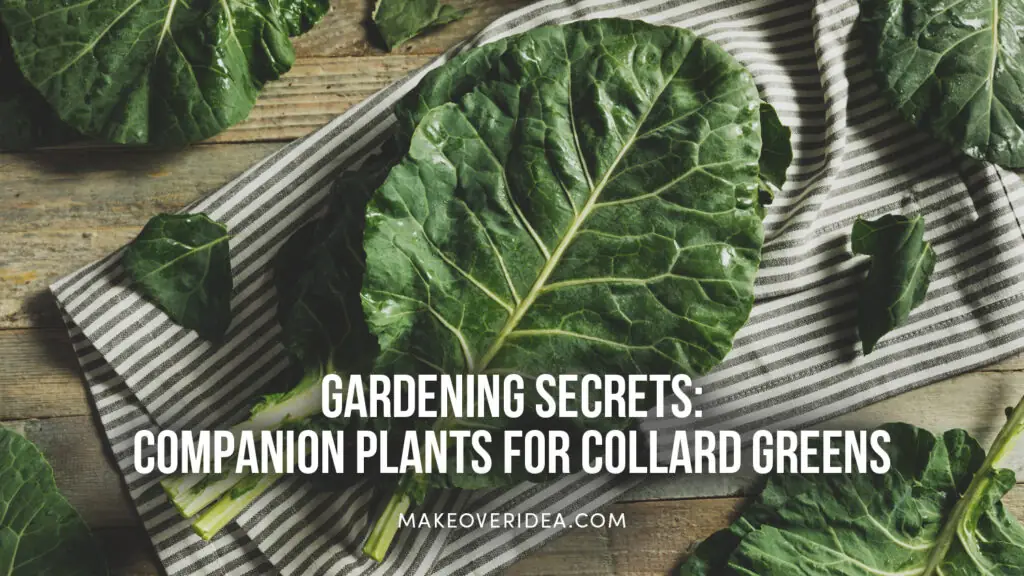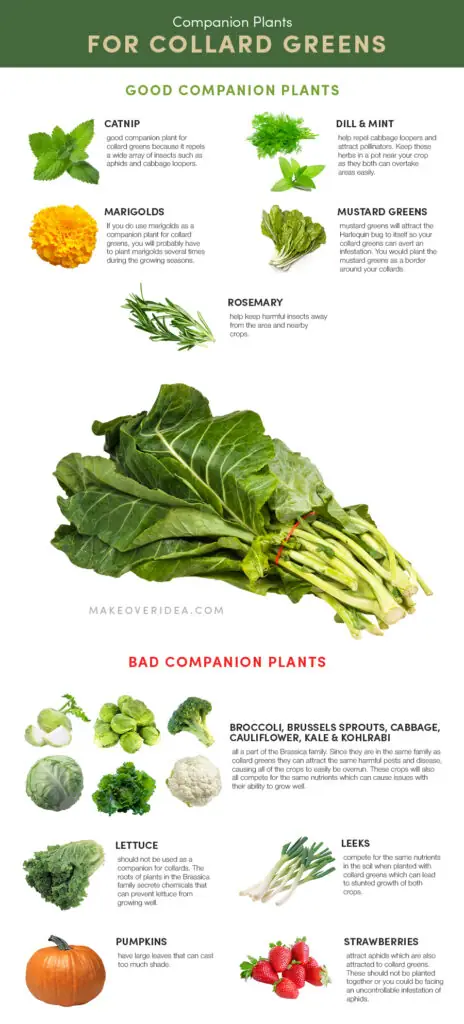Companion Plants for Collard Greens: A Detailed Guide

Do you want to maximize the potential of your collard greens garden? One of the best ways to do this is by using companion plants for collard greens.
This well-known loose-leafed cabbage is famous for its thick leaves with a slightly bitter taste: there is evidence that it was grown in the times of ancient Greece. Boost its yields by consulting this article that will walk you through the magic of companion planting, highlighting the best companions for your loose-leafed cabbage and explaining why they work so well together.
The Magic of Companion Planting
Companion planting is a time-tested gardening technique that involves growing different plant species close together to provide mutual benefits. Gardeners and farmers have used this method for centuries to improve crop yield, manage pests, and enhance overall garden health.
What is Companion Planting?
Companion planting is the strategic placement of different plant species near one another to take advantage of their natural strengths and create symbiotic relationships. These relationships can involve pest control, nutrient sharing, and even physical support.
By choosing the right companion plants, gardeners can create a more resilient and productive garden ecosystem.
Benefits of Companion Planting
Companion planting offers numerous benefits for your collards, including:
- Improved pest control: Some companions can repel or distract pests that would otherwise harm your loose-leafed cabbage.
- Enhanced nutrient uptake: Certain companions help improve soil fertility or aid in nutrient absorption, providing essential nutrients for your collards.
- Better pollination: Attracting pollinators with companions can lead to increased collard greens yields.
- Space optimization: Planting compatible species together allows for better use of garden space and resources.
Best Companion Plants for Collard Greens
When choosing companions for your loose-leafed cabbage, consider flowers, herbs, vegetables, and even trees that offer benefits to your greens. The companion planting table you can find below will be of great help:
| Good Companion Plant | Benefits for Growing Collard Greens |
| Marigolds | Repel pests and nematodes, improve soil health |
| Nasturtiums | Deter aphids and cabbage worms, add visual appeal |
| Tansy | Repel cabbage worms, ants, and flies; improve soil health |
| Oregano | Deter pests, enhance the flavor of your loose-leafed cabbage |
| Dill | Attract beneficial insects and repel pests; complementary flavors |
| Sage | Repel cabbage moths, and enhance the flavor of collard greens |
| Thyme | Deter pests, improve soil health, and complementary flavors |
| Rosemary | Repel cabbage moths and other pests; enhance flavor |
| Peppermint | Repel aphids, ants, and cabbage moths; enhance flavor |
| Chamomile | Attract beneficial insects, improve soil health |
| Beets | Share nutrients with loose-leafed cabbage, improve soil quality |
| Celery | Complementary growth habits, deter pests |
| Potatoes | Repel pests, improve soil health, and complementary growth habits |
| Onions | Just like potatoes, onions deter pests, improve soil health, and complementary growth habits |
| Spinach | Shade your loose-leafed cabbage, complementary growth habits |
Worst Collard Companion Plants to Avoid
While many plants are beneficial to loose-leafed cabbage, there are some that can have negative effects when grown in close proximity. Understanding which plants to avoid can help ensure a healthy and productive garden.
Brassica (Cabbage) Family: Why to Keep Them Apart
| Brassica Family Member | Reason to Avoid |
| Kale | Attracts similar pests and diseases as loose-leafed cabbage |
| Brussels Sprouts | Same issues as broccoli, as they are also part of the Brassica family |
| Cabbage | Attracts cabbage worms and other pests that target collard greens |
| Cauliflower | Competes for nutrients and can promote disease spread |
| Broccoli | Just like kale, broccoli competes for nutrients, attracts similar pests, and increases the risk of diseases |
| Kohlrabi | Can increase the risk of diseases and compete for nutrients and space |
Other Plants Harmful to Collard Greens Growth and Vice Versa
| Plant | Reason to Avoid |
| Lettuce | Collard greens secrete a chemical that inhibits lettuce root growth |
| Leeks | Compete for nutrients, leading to stunted growth |
| Pumpkins | Large leaves block sunlight, depriving loose-leafed cabbage of necessary light exposure |
| Strawberries | Attract aphids, which can infest collard greens |
| Melons | Cast shade over loose-leafed cabbage with their large leaves |
| Sunflowers | Grow tall and wide, blocking sunlight from collard greens |
| Corn | Compete for sunlight and nutrients, negatively affecting collard greens’ growth |
| Beans | Can be susceptible to mold and mildew, creating an environment for disease spread |
| Tomatoes | Attract aphids, increasing the risk of infestations |
| Nightshades | Susceptible to verticillium wilt, which can spread to loose-leafed cabbage and harm it more quickly |
Companion Planting Chart
This visual guide will help you create the perfect garden layout by showing which plants thrive alongside collard greens and which ones to avoid. Just follow the infographic below to optimize your collard greens’ growth and enjoy a healthy, flourishing garden.

Conclusion
Companion plants for collard greens can significantly enhance the health and productivity of your garden. By carefully selecting the right plants to grow alongside your loose-leafed cabbage, you can improve pest control, optimize space, and create a more harmonious garden ecosystem.
Make sure to avoid planting collard greens near plants that compete for resources, attract similar pests, or promote the spread of diseases. With the right companions, your collard greens will thrive and reward you with a bountiful harvest.